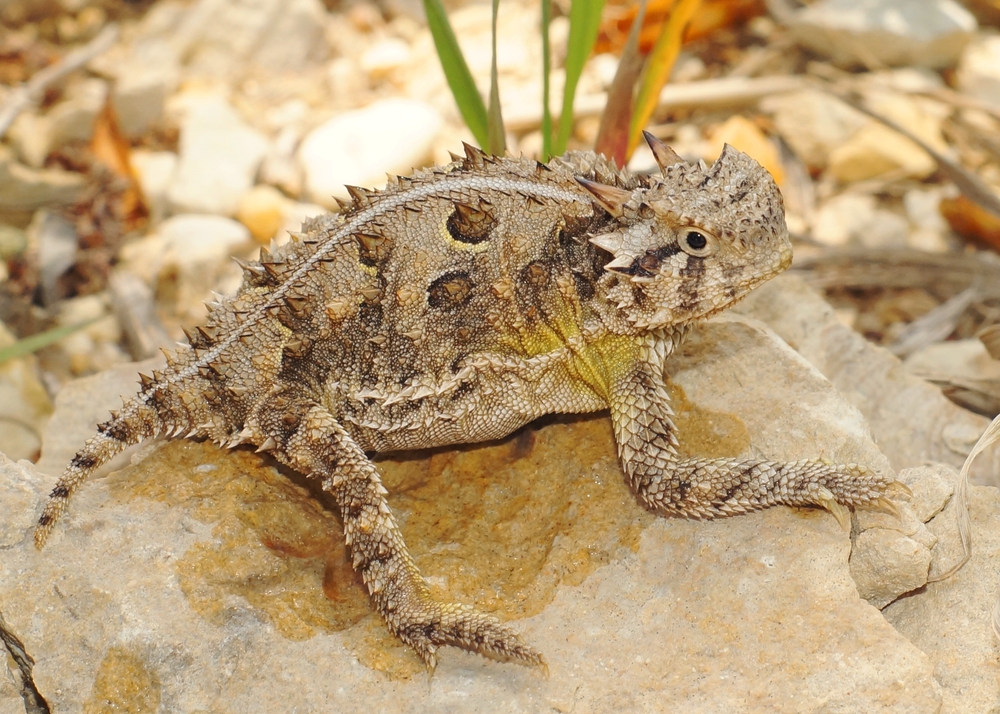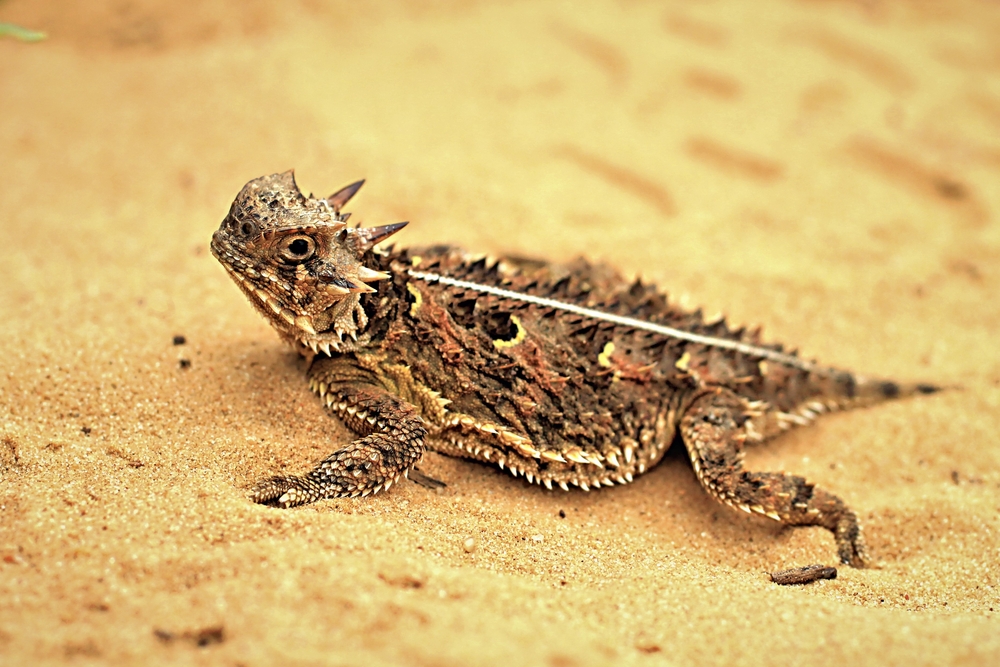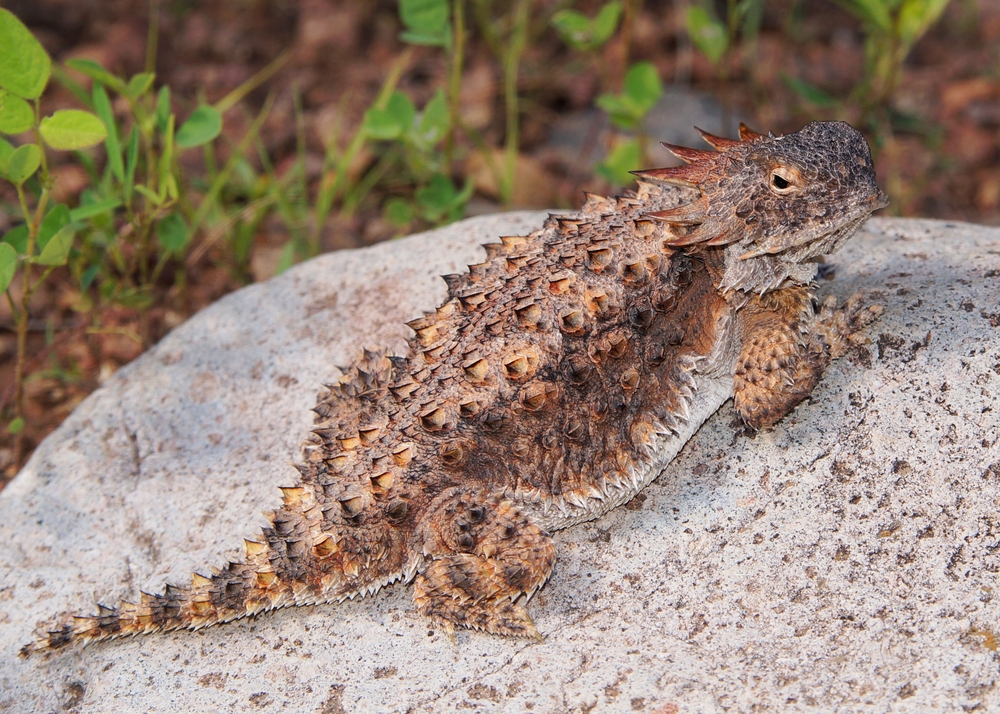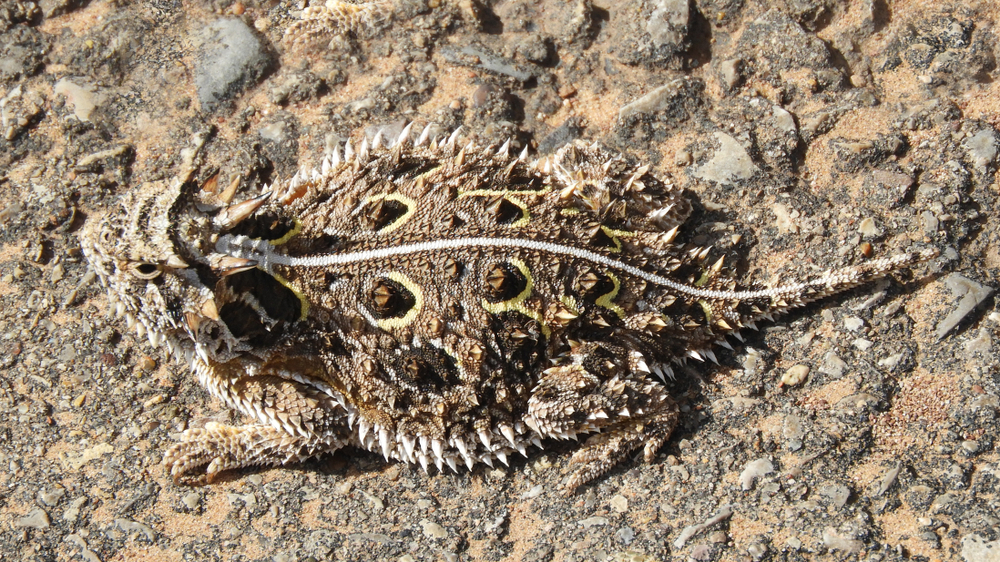About
The Texas Horned Lizard, scientifically known as Phrynosoma cornutum, is a reptile species belonging to the Animal Kingdom’s phylum Chordata and class Reptilia. It is a member of the Phrynosomatidae family, which includes various horned lizard species found across North and Central America. The Texas Horned Lizard is native to the southwestern United States, particularly Texas, Oklahoma, New Mexico, and Arizona.
These unique lizards are known for their distinctive appearance, characterized by their flattened bodies, short tails, and prominent horns on their heads. They have spiky, armor-like skin covered in scales, providing protection from predators. The coloration of Texas Horned Lizards varies depending on their habitat, ranging from light gray to brownish-red, often blending in with their surroundings.
Texas Horned Lizards are primarily insectivores, feeding on ants, beetles, and other small invertebrates. They are sit-and-wait predators, using their camouflaged appearance to ambush unsuspecting prey. When threatened, they can inflate their bodies, making themselves appear larger, and can squirt blood from their eyes as a defense mechanism against predators.
Conservation Concerns
The Texas Horned Lizard faces various conservation challenges, primarily due to habitat loss and fragmentation caused by urbanization, agriculture, and development. The loss of native grasslands and shrublands, which are their preferred habitats, has led to population declines across their range.
Additionally, the introduction of non-native species, such as fire ants, has had detrimental effects on Texas Horned Lizard populations. Fire ants compete with native ant species, reducing the availability of prey for horned lizards and impacting their survival.
As of now, the Texas Horned Lizard is listed as “Near Threatened” on the IUCN Red List. Although localized conservation efforts are underway to protect remaining populations and their habitats, continued habitat conservation and management are crucial to ensuring the long-term survival of this iconic reptile species.
Physical Characteristics
The Texas Horned Lizard (Phrynosoma cornutum), often referred to as the “horned toad” or “horny toad” due to its toad-like appearance, is a distinctive species of lizard native to the southern United States and northern Mexico. Renowned for its unique defensive mechanisms and striking physical features, this lizard has become a symbol of the American Southwest. Here’s a detailed look at the physical characteristics of the Texas Horned Lizard:
Size
- Body Length: Adult Texas Horned Lizards typically measure between 2.5 to 4.5 inches (6.4 to 11.4 centimeters) in length from snout to vent.
- Weight: They usually weigh between 0.8 to 1.3 ounces (25 to 37 grams), with some variation depending on age, sex, and environmental conditions.
Physical Characteristics
- Body Shape: The body is wide and flattened, which helps in thermal regulation and makes it more difficult for predators to swallow. This shape also allows the lizard to blend into the ground, aiding in camouflage.
- Skin and Coloration: The skin is covered in short, spiny scales that provide protection from predators. Coloration can range from sandy to dark brown, often with patterns of darker spots or stripes that help the lizard blend into its desert and grassland habitats.
- Horns and Spines: True to its name, the Texas Horned Lizard has prominent, pointed horns on its head, consisting of two central head horns that are the longest, with smaller horns arrayed along the sides of the head. The body and tail also feature rows of spiny scales.
- Eyes: They have relatively large, round eyes with movable eyelids.
- Mouth: The mouth is small and equipped with a sticky tongue, used to catch ants and other insects.
Behavior and Adaptations
- Diet: The Texas Horned Lizard primarily feeds on ants, especially harvester ants, but will also eat other small insects and invertebrates.
- Defensive Mechanisms: When threatened, it can inflate its body to appear larger. It also has the remarkable ability to squirt a stream of blood from its eyes as a defense mechanism against predators. This blood can contain foul-tasting chemicals that deter canine and feline predators.
- Habitat: Texas Horned Lizards favor arid and semi-arid environments, including deserts, grasslands, and open areas with sparse vegetation. They are well adapted to hot, sandy environments.
- Reproduction: They are oviparous, laying clutches of eggs that are buried in the sand. The eggs hatch in late summer or early fall, depending on the timing of the rains and the temperature.
The Texas Horned Lizard’s distinctive appearance, from its horned head to its spiny body, along with its fascinating defensive behaviors, make it a subject of much interest and affection in its native range. However, habitat loss, the spread of invasive ant species, and other environmental pressures have led to declines in many populations, highlighting the need for conservation efforts to protect this iconic lizard.
Reproduction
The reproductive cycle of the Texas Horned Lizard, known for its distinctive appearance and defensive behaviors, involves several key stages:
Maturity and Courtship: Texas Horned Lizards reach sexual maturity at around two years of age. During the breeding season, which typically occurs in the spring and early summer months, males actively seek out females for mating. Courtship behaviors may include head bobbing, tail movements, and the emission of pheromones to attract potential mates.
Mate Location and Communication: Males locate receptive females through olfactory cues and visual signals. Once a male locates a female, he engages in courtship displays to communicate his intentions and assess the female’s receptivity.
Courtship Rituals: Male Texas Horned Lizards engage in elaborate courtship rituals, which may involve circling the female, displaying their brightly colored ventral sides, and engaging in push-up displays to impress the female. These displays also serve to establish the male’s dominance and suitability as a mate.
Copulation: If the female accepts the male’s advances, copulation occurs. The male mounts the female from behind and inserts his hemipenes to transfer sperm. Copulation may last for several minutes to several hours, during which time the male ensures successful fertilization.
Egg Deposition: Following copulation, the female seeks out suitable nesting sites to deposit her eggs. Texas Horned Lizards typically prefer sandy or loose soil for nesting. The female excavates a shallow burrow or depression in the ground using her hind limbs and deposits a clutch of eggs.
Incubation Period: The eggs are left unattended by the female and are vulnerable to predation and environmental factors. The incubation period lasts for several weeks, during which time the eggs are exposed to ambient temperatures and moisture levels. Incubation temperature influences the sex of the offspring, with warmer temperatures producing females and cooler temperatures producing males.
Hatching and Offspring Care: Upon hatching, the young Texas Horned Lizards emerge from the eggs fully formed and capable of independent movement. They must fend for themselves from birth, relying on camouflage and defensive behaviors to avoid predation. Parental care is minimal, and the young disperse shortly after hatching to begin their solitary lives.
Understanding the reproductive cycle of the Texas Horned Lizard is essential for conservation efforts aimed at preserving this iconic species and its unique habitat. Conservation measures may include habitat protection, captive breeding programs, and efforts to mitigate threats such as habitat loss, fragmentation, and climate change. By safeguarding the reproductive success of Texas Horned Lizards, conservationists can help ensure the long-term survival of this fascinating reptile.
Lifespan
The Texas Horned Lizard, also known as the “horny toad” or “horned frog,” is a unique reptile species native to the southwestern United States and parts of Mexico. Known for its distinctive appearance characterized by spiky protrusions on its body and its ability to shoot blood from its eyes as a defense mechanism, the Texas Horned Lizard is a fascinating creature often admired by reptile enthusiasts. Here’s an overview of its lifespan and the threats it faces:
Lifespan in the Wild: In their natural habitat, Texas Horned Lizards have an average lifespan of 5 to 8 years. However, individual lifespans can vary based on factors such as environmental conditions, availability of food and water, predation, and human activities. Despite their unique adaptations for survival, Texas Horned Lizards face various threats that can impact their longevity and population health.
Lifespan in Captivity: While some Texas Horned Lizards may adapt to captive environments, their lifespan in captivity can vary. Proper care, habitat replication, and diet management are essential factors that contribute to their well-being and longevity in captivity. However, captive breeding programs and conservation efforts are not as common for Texas Horned Lizards compared to other reptile species, which may limit opportunities for research on their captive lifespan.
Threats to the Texas Horned Lizard:
- Habitat Loss and Fragmentation: Urbanization, agricultural expansion, and habitat conversion pose significant threats to Texas Horned Lizards by reducing the availability of suitable habitats. Fragmentation of their native habitats isolates populations, disrupts migration patterns, and decreases genetic diversity, making them more vulnerable to extinction.
- Climate Change: Climate change can affect the distribution, abundance, and reproductive success of Texas Horned Lizards. Shifts in temperature and precipitation patterns may alter their preferred habitats and influence prey availability. Additionally, extreme weather events such as droughts and heatwaves can directly impact lizard populations and their ability to survive and reproduce.
- Predation: Texas Horned Lizards face predation from a variety of natural predators, including birds of prey, snakes, mammals, and other reptiles. Despite their defensive adaptations, such as camouflage and their ability to inflate their bodies, they remain vulnerable to predation, especially during vulnerable life stages such as hatching and juvenile development.
- Pesticide Use: Exposure to pesticides and chemical pollutants poses a significant threat to Texas Horned Lizards, as they may ingest or absorb toxic substances from contaminated prey or habitats. Pesticide use in agricultural areas and residential areas can directly harm lizard populations and disrupt their physiological functions, leading to population declines.
- Illegal Collection and Trade: Texas Horned Lizards are sometimes captured and traded illegally for the pet trade or as curiosities. Unregulated collection can deplete wild populations, disrupt natural ecosystems, and undermine conservation efforts aimed at protecting these reptiles.
Conservation efforts focused on habitat preservation, restoration of native landscapes, implementation of sustainable land-use practices, and public education are crucial for the long-term survival of Texas Horned Lizards. Additionally, research on their ecology, behavior, and population dynamics can inform conservation strategies and management plans aimed at mitigating threats and ensuring their continued existence in the wild.
Eating Habits
The Texas Horned Lizard, also known as the “horny toad” or “horned frog,” is a species of lizard native to the southern United States and Mexico. These distinctive reptiles are known for their spiky appearance and characteristic horns on their heads. Understanding their eating habits provides insight into their ecological role and behavior.
Diet: The Texas Horned Lizard is primarily insectivorous, meaning it mainly eats insects. Its diet consists of a variety of small invertebrates, including ants, beetles, grasshoppers, and other arthropods. These lizards are particularly fond of harvester ants and will actively seek them out as a primary food source.
Foraging Behavior: Texas Horned Lizards employ a sit-and-wait hunting strategy to capture prey. They typically sit motionless in sandy or rocky habitats, relying on their camouflage to blend in with their surroundings. When an unsuspecting insect ventures too close, the lizard quickly darts forward and captures it with its sticky tongue.
Ant Specialist: One notable aspect of the Texas Horned Lizard’s diet is its specialization in consuming ants. These lizards have specialized adaptations, including a thick tongue coated with mucus, which allows them to efficiently capture and consume large numbers of ants. They are particularly adept at hunting harvester ants, which are abundant in their natural habitat.
Feeding Techniques: When hunting ants, Texas Horned Lizards use several feeding techniques to capture their prey. They may actively pursue individual ants or sit near ant trails and ambush passing insects. These lizards are also known to flick their tongues rapidly to capture multiple ants in quick succession.
Dietary Adaptations: The Texas Horned Lizard has several adaptations that make it well-suited for its insectivorous diet. Its flattened body shape and coloration provide camouflage against the sandy or rocky substrate, allowing it to remain hidden from both predators and prey. Additionally, its wide mouth and expandable throat allow it to swallow large insects whole.
Seasonal Variation: The diet of Texas Horned Lizards may vary seasonally based on factors such as prey availability and environmental conditions. During periods of high insect abundance, such as spring and summer, these lizards may consume larger quantities of insects to meet their energy requirements. In contrast, during cooler months or times of reduced insect activity, they may rely on alternative food sources or enter periods of reduced activity.
Conservation Considerations: Texas Horned Lizards face threats from habitat loss, fragmentation, and pesticide use, which can negatively impact their insect prey populations. Conservation efforts aimed at preserving their native habitats, including grasslands, scrublands, and desert ecosystems, are essential for ensuring the survival of this iconic lizard species. Additionally, raising awareness about the importance of maintaining healthy insect populations and reducing pesticide use can help support the long-term conservation of Texas Horned Lizards and their prey.
Uniqueness
The Texas Horned Lizard, also known as the “horny toad” or “horned frog,” is a unique reptile native to the southwestern United States and parts of Mexico. Here are some key aspects that make the Texas Horned Lizard unique:
Physical Appearance: The Texas Horned Lizard is known for its distinctive appearance, characterized by its flattened, oval-shaped body covered in pointed scales and horns. These horned projections give the lizard its name and serve as a form of defense against predators. The lizard’s coloration varies depending on its environment, ranging from grayish-brown to reddish-brown, allowing it to blend in with its surroundings.
Habitat: Texas Horned Lizards inhabit a range of arid and semi-arid habitats, including desert scrublands, grasslands, and open woodlands. They are often found in areas with sandy or rocky soils where they can burrow and seek shelter from predators and extreme temperatures.
Diet: Texas Horned Lizards are primarily insectivorous, feeding on a variety of small insects, including ants, beetles, grasshoppers, and spiders. They are sit-and-wait predators, using their keen eyesight and camouflage to ambush prey. The lizards flick their sticky tongues to capture unsuspecting insects, aided by rows of sharp teeth along the edges of their jaws.
Defense Mechanisms: When threatened, Texas Horned Lizards have several defense mechanisms to deter predators. Their first line of defense is camouflage, using their coloration and body shape to blend in with their surroundings. If approached too closely, they may inflate their bodies with air to appear larger and more intimidating. Additionally, they can squirt a stream of blood from the corners of their eyes as a last resort, which may startle or deter predators.
Reproduction: Texas Horned Lizards breed in the spring and summer months, with females laying clutches of eggs in sandy or gravelly soil. The eggs are buried in shallow nests and left unattended to incubate for several weeks until they hatch. Hatchlings emerge from the nest fully formed and independent, resembling miniature versions of adults.
Conservation Status: Texas Horned Lizards face threats from habitat loss, fragmentation, and fragmentation due to urban development, agriculture, and invasive species. Additionally, they are sometimes collected for the pet trade, although this practice is regulated in many areas. Conservation efforts focused on habitat preservation, restoration, and public education are important for ensuring the long-term survival of Texas Horned Lizard populations.
Cultural Significance: Texas Horned Lizards hold cultural significance in the southwestern United States, where they are often regarded with affection and nostalgia. They are sometimes considered symbols of the region’s rugged landscapes and unique wildlife.
Texas Horned Lizards’ distinctive appearance, behavior, and ecological adaptations make them fascinating and iconic reptiles of the southwestern United States. Studying and conserving these lizards can provide valuable insights into the ecology of arid ecosystems and the importance of preserving native biodiversity.
Sources
- Burnie, David & Wilson, Don, Animal, Smithsonian Institute, Washington DC.
- Hickman et al, Integrated Principle of Zoology, McGraw Hill, Boston.
- Paragon, The Ultimate Guide to Wildlife in North America, Atlantic Publishing, UK.




































































